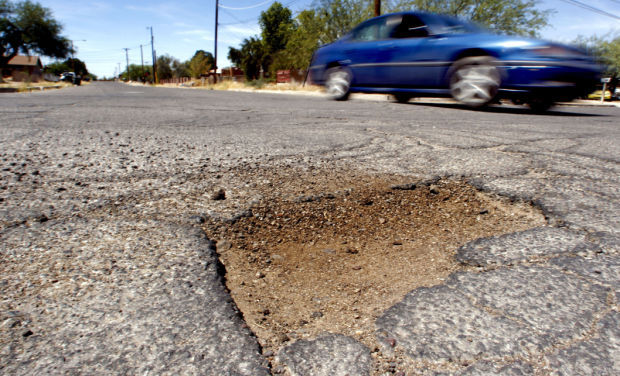HURF is not the most attractive acronym.
Say it out loud, and it sounds like a dog trying to bark just as a bad bowl of kibbles makes its way up and out the wrong direction.
However it may sound, HURF, or the Highway User Revenue Fund, is the most important source of funds for the building and maintenance of roads across the state. The pot of money, nearly $1.3 billion last year, is split between the state, counties and cities according to a formula that some Pima County officials say is due for an update.
As it stands, the state gets roughly half, cities and towns get around 30 percent, and counties get the rest.
The rub, in some people’s opinion, is how the county share is then divided up among Arizona’s 15 counties, all of which no doubt have long and growing lists of road repairs and not enough money to tackle them.
This gets a little complicated, but with millions at stake and rough roads a perennial Pima County complaint, it’s worth understanding (the Road Runner must confess that he has only spoken with people who are experts on the matter, and is no expert himself).
The county HURF distribution formula takes two things into consideration and weighs them differently: each county’s sales of gasoline and use of diesel fuel and other so-called “use fuels” relative to the rest of the state, which is 72 percent of the formula, and unincorporated population, which is the remainder.
With that formula, Pima County got nearly $41 million in fiscal year 2015 and Maricopa County got a few million shy of $100 million.
However, as County Administrator Chuck Huckelberry often points out, the population in unincorporated Pima County, is around 360,000, roughly 70,000 more than in Maricopa.
That’s why he is recommending that one of the county’s lobbyists, Michael Racy, pursue changes in the HURF formula during next year’s legislative session so that the unincorporated population is weighted equally to gas sales. According to estimates in a June 16 memo, that change would have resulted in roughly $6 million more for Pima County last year.
“This formula would be more equitable because it would reflect the fact that Pima County has a greater number of unincorporated residents, and hence, a greater demand for road repair, maintenance and improvements,” Huckelberry’s memo reads.
But it would have also led to a $15 million drop in Maricopa’s share and much smaller declines in Greenlee and La Paz counties.
Sounds like a tough sell in Phoenix, right?
But maybe not quite as hard as it seems at first glance, Racy says, adding he would push for a plan that would hold those three counties “harmless,” meaning other state revenues would be use to plug their HURF holes.
Where would that extra money come from? Whether it’s shifting vehicle licensing taxes, increasing the state’s 18-cent gas tax or other policy measures, Racy said that ideally, the formula reform would be a part of a larger state-level effort to take a look at ways to improve transportation funding.
Whatever the solution, he said it will be “tough to accomplish, but we have to try.”
There are precedents for success. In fact, Racy pointed out, the current county HURF formula was the result of legislative reforms in 1996 that for the first time took unincorporated population into account, which immediately benefited Pima County. The 1990s also saw reforms to sales tax distribution and the way counties pay for the state Medicaid system’s long-term care program.
“In every one of those examples, the Legislature recognized the inequity,” Racy said.
However, a more skeptical state Sen. Steve Farley, D-Tucson, said, “If we had the Legislature of the mid-1990s, I could do a whole lot of things that aren’t possible now.”
“I am very concerned that once you open up the HURF distribution formula, then you are going to have to go with whatever the majority decides. The majority of legislators are from Maricopa County,” he said, adding later: “This could backfire on us. I’ve learned to be very careful about proposing something that could be used against you.”
Farley’s preference for increasing funds for road work in Pima County is finding ways to increase revenues for them statewide, “instead of arguing over how we’re going to divide the pie.” Where Racy and Farley have no disagreement is on the very real need to find a funding solution.
“We’re going to be driving on dirt roads in the entire state of Arizona outside of Maricopa County if we continue to do nothing,” Racy said.
DOWN THE ROAD
- On Tuesday, crews will start saw-cutting across Broadway at its intersection with Stone Avenue from 5 a.m. to 1 p.m. Travel restrictions will be in place weekdays as construction proceeds, though at least one lane will be open in both directions.
The work is part of the larger Stone Avenue-Drachman Street to First Street Roadway Improvement Project, which is slated to cost $2.5 million and will be completed next spring.
- For motorists with Rocky Point plans, ADOT is set to start work on Arizona 86 east of Sells, also on Tuesday. Crews will be milling asphalt along a 2.5-mile stretch in preparation for paving slated to start Friday. Work will take place Monday through Saturday from 5 a.m. to 6 p.m., and pilot cars will lead motorists through one-lane sections. The project is expected to last three weeks.





